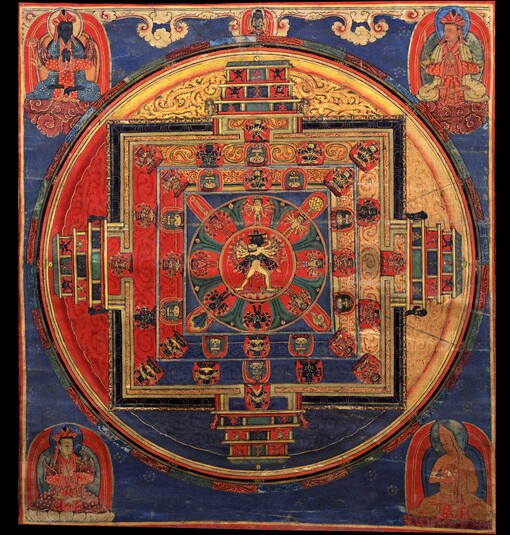
Item: Mandala of Kalachakra (Buddhist Deity)
| Origin Location | Tibet |
|---|---|
| Date Range | 1500 - 1599 |
| Lineages | Uncertain |
| Material | Ground Mineral Pigment on Cotton |
| Collection | Carolyn and Wesley Halpert |
Classification: Deity
Shri Kalachakra Mandala (Tibetan: pal du kyi kor lo kyil kor. English: the Mandala of the Glorious Wheel of Time): surrounded by the three pre-eminent scholar Kings of Shambhala.
Sanskrit: Kalachakra Tibetan: Du kyi kor lo
Tibetan: Du kyi kor lo
At the center is Shri Kalachakra, predominantly blue, with four faces, twenty-four hands and two legs, embraced by the consort, Vishvamata, yellow with four faces and eight hands. Adorned with crowns, gold and jewel ornaments and an array of hand objects they stand atop two prone figures and lotus blossom surrounded by the red flames of pristine awareness. Standing in a circle, eight figures each with three faces and eight hands, in an assortment of colours, surround the central deity. Outside of the inner enclosure are eight seated figures embracing consorts alternating between golden vases. Outside of that are twelve figures with consorts and four guardian deities standing watch at the four doors. In the protruding structures of the four doors are eight small figures of various colours.
The floor of the celestial palace is divided into four colours ornately patterned with floral designs: yellow, white, blue and red. The four doors represented at each side by the 'T' shaped structures each have four levels. The outer black lines forming a square enclosure represent the stylized decorative facade on the four sides of the upper palace roof. Surrounding that are concentric rings of various colours with the final ring composed of the multi-coloured flames of pristine awareness completely encircling. At the top center is the primordial buddha Vajradhara, blue in colour with the two hands folded across the heart holding a vajra and bell. At the left is Suchandra, King of Shambhala, emanation of Vajrapani, blue in colour with the two hands held at the heart in the mudra (gesture) of teaching and holding the stem of a lotus blossoming at the right shoulder supporting a gold vajra. Richly attired in opulent garb and a headdress of various colours in sits in vajra posture on a seat of swirling pink clouds surrounded by a red nimbus. Suchandra received the Kalachakra teachings directly from the buddha Shakyamuni at the Dhanyakataka caitya at Amaravati in South India and later safeguarded the teachings in the northern central Asian kingdom of Shambhala. At the right in similar appearance is Manjukirti, 8th King of Shambhala and founder of the Kulika lineage of royal descent, emanation of Manjushri, orange in colour. With the two hands held to the heart in the teaching mudra he holds the stems of two utpala blossoms supporting a wisdom sword and book.
At the bottom left, again in similar attire, is Pundarika, emanation of Avalokiteshvara, holding the stem of a lotus. At the right is an Indian pandita wearing the robes of a monk and the hat of a scholar with the hands performing the mudra of Dharma teaching. Seated in vajra posture atop a pink lotus blossom he is surrounded by a bright red nimbus of light.
The Kalachakra belongs to the non-dual Anuttarayoga Tantra practiced to a greater or lesser degree by all schools of Tibetan Buddhism. The concept of 'time' is used as the special metaphor to symbolize the process of transformation from mundane existence to complete enlightenment. From amongst the numerous lineages to enter Tibet the Rwa and Dro are the most famous. The Sakya school maintains seven distinct lineages of transmission.
Rwa Lineage: Buddha Shakyamuni-Kalachakra, the Shambala king Suchandra, a line of 8 Shambala kings ending with Manjukirti and Pundarika, an unnamed Manjushri emanation, Chilu Pandita, Pindo Acharya, Kalachakrapada the younger (Naropa), Manjukirti, Samantashri, Rwa Chorab, Rwa Yeshe Sengge, etc.
Anupama Lineage: Vajradhara, Vajra Garbha, Vajra Dakini, Vajracharya Chilupa, Kalachakra the Greater, Kalachakra the Lesser, Anupama Rakshita, Sadhuputra, Dharmakara, Dharmamitra, Bikshata Deva, Panchen Shakyashri, Sakya Pandita Kunga Gyaltsen (1182-1251), Chogyal Pagpa (1235-1280), etc.
Jeff Watt 3-99
Collection: Christie's, Painting (September, 2003; NY)
Collection of Caroline & Wesley Halpert
Mandala: Mandala Main Page
Buddhist Deity: Kalachakra Main Page
Buddhist Deity: Kalachakra Mandala
